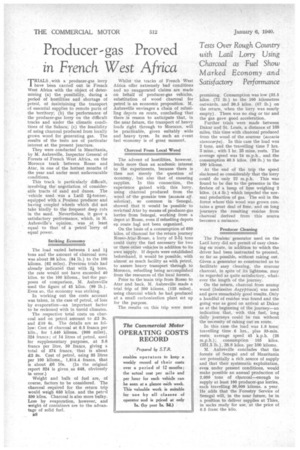To Expedite the Painting of White Traffic Lines
Page 34

If you've noticed an error in this article please click here to report it so we can fix it.
(AVER a year ago a group of men connected with road NJ transport witnessed an incident that nearly became an accident to road workers employed on painting white lines. This happening set moving a train of thought that has culminated in the production of the Autopainter, a little vehicle that automatically paints a white line as it is driven along the road. The introduction of this machine was forecast in The Commercial Motor dated December 2, 1938.
Early inquiries, on the part of its designers, showed that, apart from any question of danger, the work of painting roads by hand was not popular With local authorities' staffs, whilst surveycrs experienced difficulties due to the time occupied by manual methods. Lengthy experiments followed, and various devices were tested.
In its final form the machine is based on a Fordson Tug 8 h.p. three-wheeler. It is designed to paint lines automatically at a speed of 3 m.p.h. to 5 m.p.h. and economic operation is a feature. Compared with manual methods, paint consumption alone is stated to be reduced by at least a quarter, and time saving is, of course, much greater.
Three tanks are carried on the small lorry body of the Fordson. They contain, respectively, yellow paint, white paint and solvent. The required supply is selected by means of a key tap and is drawn by suction to a direct acting pump, housed on the near side of the engine and driven by chain from the front end of the crankshaft, through a simple dog-clutch. Thence the paint flows under pressure to a spray gun, which is fitted between circular plates on the off side of the engine.. When the machine is ready for work, the entire spraying mechanism is lowered to the ground by means of a screw handle. With the mechanism in the raised position, the machine can travel at normal road speeds.
The paint is discharged through the small orifice in the spray gun and is forced on to a deflector plate which gives a wide beam, the actual width being controlled by the setting of two rolling discs which touch the surface and guard against irregularities on the edges of the line. Ordinarily, widths can be set between n ins. and 5i ins., but a wider range is easily arranged if-required. The use of a threewheeler precludes any risk of the line being over-run by the rear wheels when cornering. Because intermittent lines are demanded in the majority of instances, provision is made for automatic operation of the spray in this manner. A simple
B28
adjustment regulates the gun so as to treat 3 ft. out of every 18 ft., or any multiple of 3 ft. out of every 18 ft.
In spray-painting mechanism, difficulties are frequently encountered through clogging or settling, but with the Autopainter the valve of the gun is made so that, when in the open position, the paint is sprayed on to the road, but when closed it is pumped back into the tank. This means that the paint is constantly stirred and is kept at an even density and colour. As mentioned earlier, a suitable solvent is carried in one of the tanks and, after use, the paint taps are closed and the solvent valve opened. The solvent is pumped through the entire system and the whole mechanism is cleansed without further attention or any dismantling.
A further attachment that is now under final test deals with kerb painting.. This device is attached to the near side of the vehicle by means of a splined shaft, and paints, at the same time, both the vertical and the horizontal faces of the kerb. Self-contained, it is easily removed when not in use.
Owing to the speed at which the lines are painted, it was necessary to evolve a special paint that would dry quickly without losing body or adhesion. The mixture now used is stated to fulfil all requirements, to spray perfectly, to have superior covering and lasting qualities and to dry hard in six minutes against the normal time of 23 minutes, also to be impervious to oil and petrol. Good results have been obtained during trials on roads carrying exceptionally heavy traffic.
The Autopainter is a product of Road Lines, Ltd., 8, Clarendon Road, Lytham St. Annes, Lancs, and the company proposes to supply highway authorities with the machines on a hire-maintenance basis, the charges including the necessary tuition, in the use of the machine, for members of the highway authorities' own staffs. ,












































































